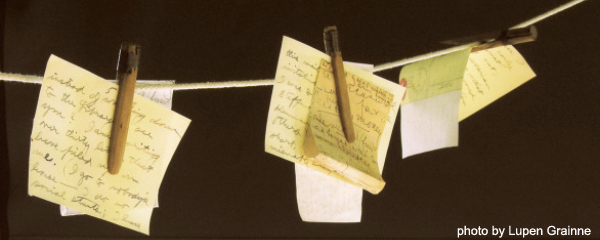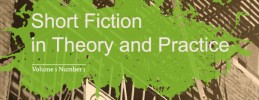
photo by Lupen Grainne
by Mike Smith
As I continue my exploration into what makes good writing successful, I want to examine the differences between what I think of as being ‘open’ and ‘closed’ sentences.
Sentence structure is fundamental to the way a story reads. Choice of words and the order of those words are often the most obvious elements of this structure. Look at Cormac McCarthy’s use of an archaic vocabulary, and his often convoluted syntax; compare the speech of Tolkien’s Elves as they describe Lothlorien with Tolkien’s own narrative voice used to describe The Shire.
There is more to sentence structure than choice and order of words, though. There are larger units to be considered and these are the phrases and clauses, the clusters of words that create single meanings: big green tent / the falling axe / from the bridge. Sequences of such clusters add meaning to meaning, and there are two fundamentally different ways within the sentence that this function is carried out. That difference is between Open and Closed sentences.
Briefly, an Open sentence is one in which each element of the sentence makes sense as you encounter it. ‘John ran out of the shop, down the road, past the Post Office, over the bridge and into the park, and realised the dog had gone’ is an Open sentence. ‘Having run out of the shop, down the road past the Post Office, over the bridge and into the park, John realised that the dog had gone’ is a closed one.
The Closed sentence does not make complete sense until we get to the last element, which, like the last piece dropped into a jigsaw, makes sense of the whole. If we look at the last element of these sentences and split it down further, ‘and realised / the dog had gone’ or ‘John realised / that the dog had gone’ we can see that it is ‘closed’, but that when re-arranged to ‘The dog had gone, / John realised’ it becomes ‘open’.
The different structures handle information in different ways. The elements of Open sentences add to or expand upon an opening that is comprehensible in itself. Closed sentences withhold the full meaning of both the parts and the whole, until the closing element. The former makes for clarity, and may be thought of as expositional. The latter makes for drama, with a revelatory flourish. The downside of the Open sentence is that it can be banal, pedestrian, and too much like a list. The downside of the Closed sentence is that it requires the reader to hold the preceding elements, not fully understood, in his memory, until the very end. The Open sentence contains separate pieces of information that are added to what we already know. The Closed sentence gives meaning to what we have already read.
The mechanism for opening or closing a sentence depends not only on the order in which the information is presented, but also in the placement of the main verb. The earlier that verb appears in a sentence, the more likely the sentence will be open.
This exploration has led me to consider the possibility that novels and short stories might exploit the different qualities of the two forms of sentences in different ways. Does the Open sentence, for instance, with its clear exposition make a good opening for a novel? Does the Closed sentence, with its meaning withheld until the end, make a good ending for a short story? Novels take us on a long cruise, but first have to get us aboard. Short stories are all about their endings.
One more thought. I pointed out that the last element of my first pair of sentences could be arranged so that they are either Open or Closed. Could, then, larger units of writing also be considered that way? Do we have Open paragraphs, chapters, or even entire stories? Do we have Closed ones? Sentences may have elements of both, opening and closing consecutively.
Below are some first and last sentences from novels and short stories, but of course you can test the theory against examples of your own as well.
‘She shook him awake into the quiet darkness.’
‘Someone should tell a blind man before setting him out that way.’
Cormac McCarthy, Outer Dark
*
‘It was now lunchtime and they were all sitting under the double green fly of the dining tent pretending that nothing had happened.’
‘Now I’ll stop.’
Ernest Hemingway, ‘The Short Happy Life of Francis Macomber’
*
‘It seems increasingly likely that I really will undertake the expedition that has been preoccupying my imagination now for some days.’
‘I should hope, then, that by the time of my employer’s return, I shall be in a position to pleasantly surprise him.’
Kazuo Ishigaru, The Remains of the Day
*
‘Leon Sipling groaned and pushed away his work papers.’
‘That now he preferred the art of that fifteenth century Dutch master of macabre and diabolical horror, Hieronymous Bosch.’
Philip K. Dick, ‘The Mold of Yancy’
Here, now, are the opening two paragraphs from a reasonably contemporary voice, Alice Munro, in the story ‘Chance’, from Runaway (Vintage, 2006):
“Halfway through June, in 1965, the term at Torrance House is over. Juliet has not been offered a permanent job – the teacher she replaced has recovered – and she could now be on her way home. But she is taking what she has described as a little detour. A little detour to see a friend up the coast.
About a month ago, she went with another teacher – Juanita, who was the only person on the staff near her age, and her only friend – to see a revival of a movie called Hiroshima Mon Amour. Juanita confessed afterwards that she herself, like the woman in the picture, was in love with a married man – the father of a student. Then Juliet said that she found herself in somewhat the same situation but had not allowed things to go on because of the tragic plight of his wife. His wife was a total invalid, more or less brain-dead. Juanita said that she wished her lover’s wife was brain-dead but she was not – she was vigorous and powerful and could get Juanita fired.”
Hemingway famously exhorted us to ‘write short sentences’, although he himself often didn’t! Short sentences are likely to be clear, and therefore probably stronger in their meaning, and Open in form. In much modern writing, often I suspect without intention or realising they have done so, writers present long sentences on the page as if they were a series of short ones, the constituent clauses being broken up by full stops and capital letters. Such sequences of fragments may themselves have the qualities of being either Open or Closed, in the way they build up our knowledge of what is being communicated.
Individually, fragments without complete verbs, or even isolated phrases, may act as something like still photographs in the moving pictures of longer structures, or like labels as opposed to messages: The cowboy looked out across the river. Sunlight on the water. Mist rising from the shoreline trees. Split by commas, these three elements would form an Open sentence. Reverse the order, though, and they would form a Closed one. The two forms allow us to do different things, to create different effects, to shift our focus. In the example above, the Open form reveals to us what the cowboy sees. The Closed one shows us the scene before revealing him as part of it.

